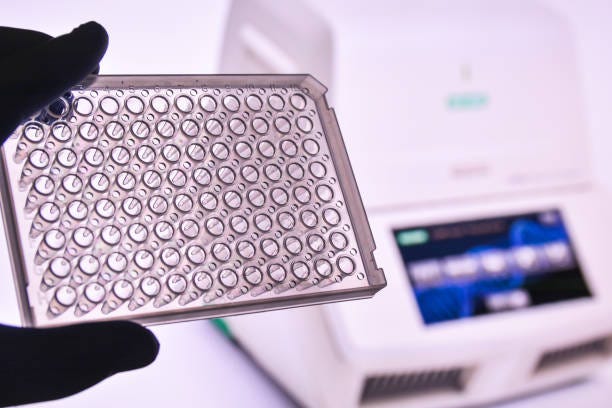Clinical Quick Reference Monthly / Autumn 2024 Edition / The 411 On PCR
CLINICAL QUICK REFERENCE GUIDES l CLINICAL CONCEPT REVIEW l PCR
The worldwide market for PCR is anticipated to exceed USD 13.75 billion by 2028, fueled by the launch of cutting-edge devices from major biotech players.
The creation and introduction of cutting-edge products in the field of PCR are expected to drive its market growth. Forecasters point to a projected rise in infectious disease, cancer, and genetic disorders, coupled with a growing demand for expedited diagnostic solutions.
What Is PCR?
PCR (or polymerase chain reaction) is a laboratory method used to increase or replicate a particular piece of DNA or RNA.
The sequence is obtained from a tiny genetic sample. This method allows researchers to create millions to billions of replicas of specific segments, making it appropriate for thorough analysis.
Kary Mullis, a U.S. biochemist, developed the polymerase chain reaction process during the 1980s.
How Does PCR Work?
Polymerase chain reaction begins by heating the sample.
Exposure to high temperatures causes the DNA to denature, or divide into strands.
Following the denaturation, an enzyme known as "Taq polymerase" helps produce fresh strands of genetic material, utilizing the original strands as templates. This procedure leads to the replication of the original sample, with each of the new molecules consisting of one old and one new strand.
Every one of these pieces can generate two additional copies, and this action continues indefinitely. The process of denaturing and making new DNA is repeated up to 30 or 40 times, which can create over one billion precise replicas of the original fragment.
In the modern laboratory, the entire operation is automated. The procedure is controlled by a device known as a thermocycler, which is programmed to change the temperature of the reaction every few minutes, efficiently facilitating DNA denaturation and synthesis.
Let’s Take a Closer Look At The Process…
Polymerase chain reactions occur in three stages. These stages are: denaturation, annealing, and extension.
Denaturation:
During this step, the parts and reagents are heated. The blend is heated for approximately 3-5 minutes. The high temperatures cause hydrogen bonds between bases to sever. Strands separate.
Annealing:
In the annealing stage, the temperature is lowered. This allows primers to bind to sequences on the template. This stage generally lasts 10-30 seconds.
Binding occurs via hydrogen bonds.
Extension:
In the extension stage, the reaction is heated to the optimal temperature for Taq polymerase to attach to the primer and begin adding nucleotides.
Nucleotides are added one by one, creating a complementary strand of DNA.
Taq polymerase is a thermostable (extremely heat-resistant) polymerase enzyme. It is extracted from the bacteria Thermus aquaticus. This bacteria was discovered in Yellowstone National Park in the 1960s.
What Are Some Common Applications of PCR?
PCR has been employed across multiple disciplines.
Let’s review some common PCR uses.
1. Biomedical research:
The process has been applied in biomedical studies to enhance certain DNA fragments for various purposes.
2.Clinical diagnostics:
PCR has been utilized to identify genetic disorders, recognize bacteria and viruses, and conduct prenatal screening.
3. Forensics:
PCR has revolutionized modern forensic investigations.
4. Agriculture:
PCR finds application in agriculture. For example, scientists are able to test for the presence of genetically modified components.
5. Human Genome Project:
The majority of mapping methods used in the Human Genome Project were based on PCR.
How To Discover More About PCR?
Click the link to read up on the use of PCR at the National Human Genome Research Institute:
https://www.genome.gov/about-genomics/fact-sheets/Polymerase-Chain-Reaction-Fact-Sheet
Helpful Video:
Basic Molecular Biology: PCR and Real-Time PCR – Principle of PCR
https://reach.cdc.gov/job-aids-resources
Medical Terminology
Study Tip: Take notes and add key points and action items in the side column of your notebook.
DNA (or deoxyribonucleic acid) - is a molecule found inside cells which carries genetic information
nucleotides - the basic building blocks of nucleic acids like DNA and RNA; these consist of nitrogen-containing bases with a sugar molecule (either deoxyribose in the case DNA, or ribose in RNA) and a phosphate group
PCR (or polymerase chain reaction) - is a laboratory method used to increase or replicate a particular piece of DNA or RNA
phylum - a grouping of organisms that share a certain degree of evolutionary relatedness; the phylum taxonomy rank is below Kingdom and above Class (in biological classification)
Taq polymerase - thermostable enzyme; helps produce fresh strands of genetic material, using original strands as templates
thermocycler - machine that can be used to automate the PCR process; provides cyclic, regulated temperatures
thermophilic - relates to an organism that is capable of surviving at very high temperatures
Thermus aquaticus - bacteria that can tolerate high temperatures; belongs to the Deinococcota phylum
Additional:
Kary Mullis - a U.S. biochemist who developed the polymerase chain reaction process during the 1980s
Don’t Forget To Like, Share, & Subscribe To Receive Study Guides Emailed Directly!
Disclaimer: The above study guide represents study materials, always seek and follow the advice of your medical provider for any acute or chronic medical issues or questions.
October/November 2024 Issue Resources:
CDC
National Human Genome Research Institute
NIH

Clinical Quick Reference Guides Companion Activity / November 2024
CLINICAL CONCEPT REVIEW l PCR
Enter a correct answer in the puzzle grid for each clue provided. Review the November issue of Clinical Quick Reference Monthly to check your answers. Subscribe to receive all materials emailed to you, or follow along in the Notes section.
Beth Kirsch, MA, BSN, RN, is a registered nurse and healthcare educator working on the East Coast.











